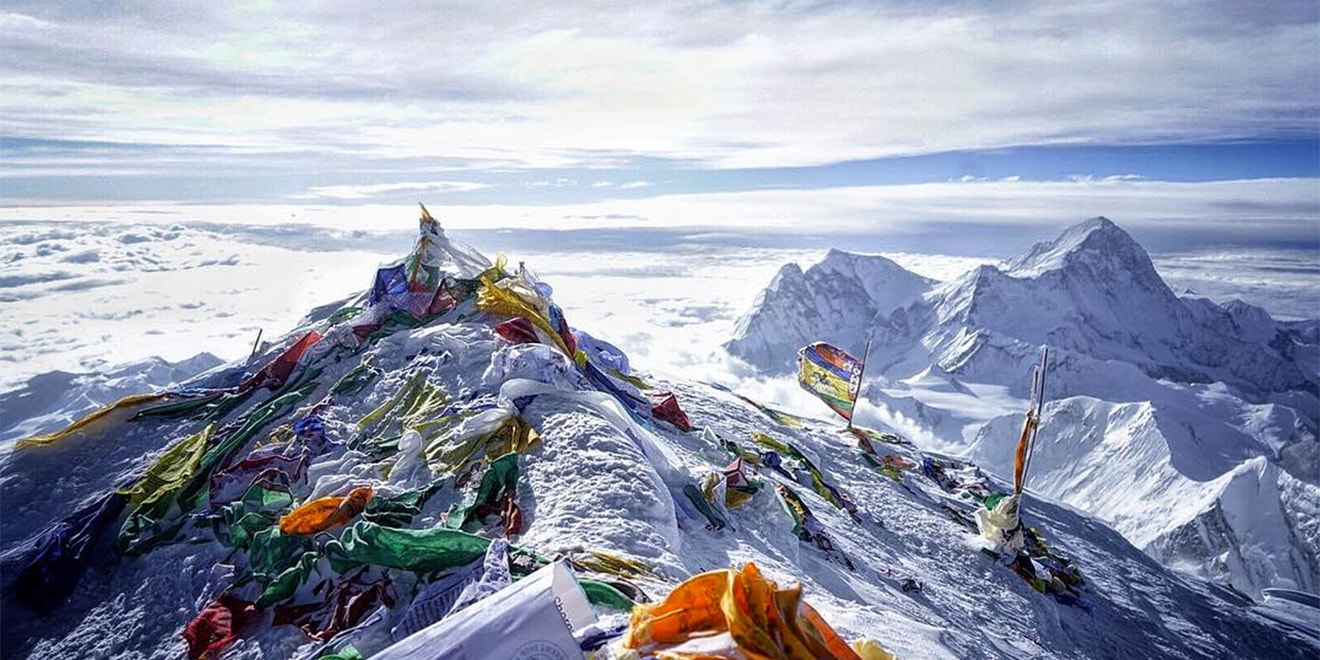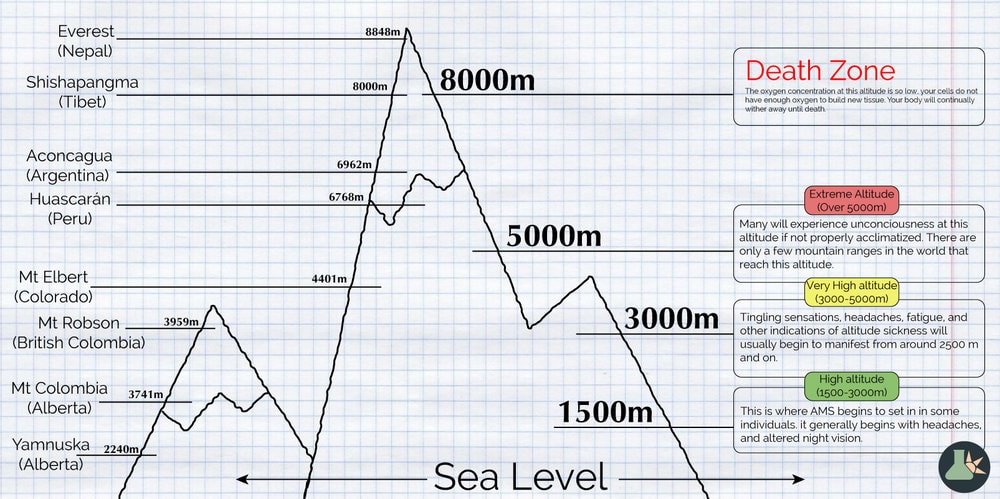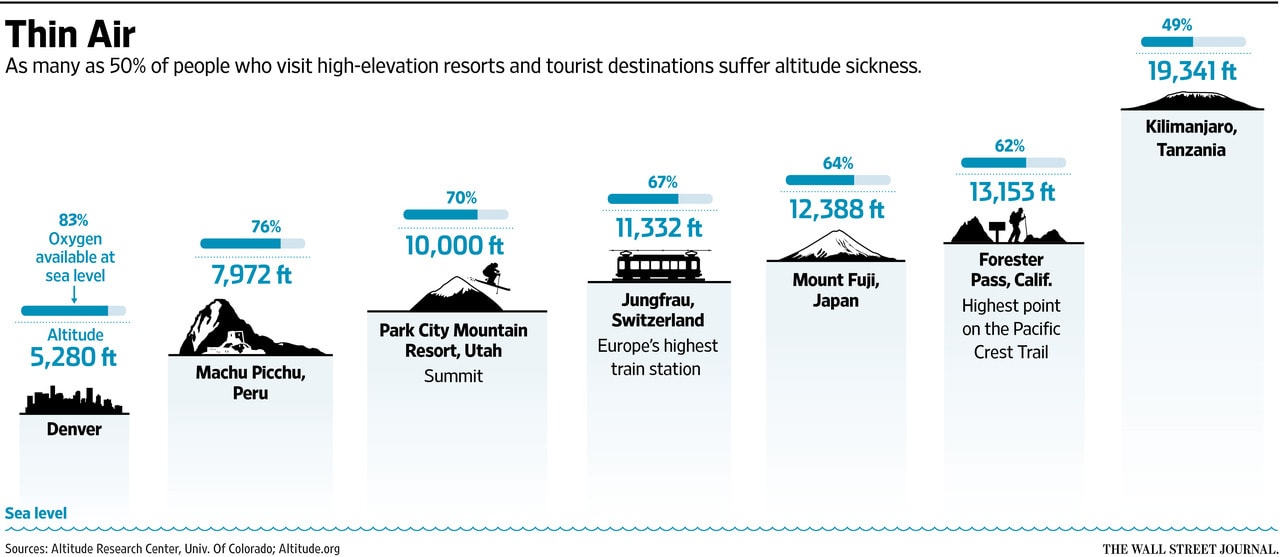
There are two ways of categorizing death at altitude; traumatic and non-traumatic. Traumatic deaths occur from the usual hazards of mountaineering; falls, avalanches, and extreme weather. They usually occur lower down rather than high up, and are quite unusual. It’s more likely that climbers die from non-traumatic causes, most notably altitude-related illnesses.
Altitude sickness has three forms. Mild altitude sickness is called acute mountain sickness (AMS) and is quite similar to a hangover – it causes headache, nausea, and fatigue. Altitude sickness happens because there is less oxygen in the air that you breathe at high altitudes. This is very common: some people are only slightly affected, others feel awful. However, if you have AMS, you should take this as a warning sign that you are at increased risk of the more serious forms of altitude sickness: HAPE and HACE.

High Altitude Pulmonary Edema (HAPE) and High Altitude Cerebral Edema (HACE) are the more severe forms of AMS. AMS affects about 40 percent of people at an altitude of up to 10,000ft (3,048m) and more than 50 percent at higher altitudes. Both HAPE and HACE can be fatal within hours. Two things are certain to make altitude sickness very likely – ascending more than 1,640ft (500m) per day, and exercising vigourously.
Physically fit individuals are not protected – even Olympic athletes get altitude sickness. And the condition may strike eager ski vacationers much more often and at lower altitudes than previously thought. HAPE occurs more commonly at moderate altitudes below 8,000ft (2,438m), and healthy, young, vacationing men may be most at risk.
Previous research had suggested that the condition occurs only at the highest altitudes, but a study in the January issue of Chest shows that it frequently occurs at more modest altitudes commonly found at major ski resorts. The occurrence of HAPE at altitudes of <8,200ft (2,500m) is said to be rare, but its incidence is probably underestimated, and the patients are often skiers or hikers who have easy access to moderate altitude and start physical activity without prior training.
As altitude increases from sea level, the atmospheric pressure decreases, taking oxygen concentration with it. This makes it more difficult to deliver oxygen to your cells. As a result, your body will need to work extra hard to meet its oxygen demands. This is then pushed even further when you start doing physical activity like climbing or hiking, which increases your body’s demand for oxygen further.

HAPE
‘Pulmonary’ refers to the lungs and ‘edema’ means that there is a build-up of fluid. So, pulmonary edema is a build-up of fluid within the lungs. This mostly happens when the person climbs too quickly to altitude and the trek involves vigorous exercise. This leads to shortage of breath (dyspnoea), cough, fast heart rate and decreased oxygen levels in the arteries. HAPE can also cause a fever and coughing up frothy spit.
It is never normal to feel breathless when you are resting – even on the summit of Everest. This should be taken as a sign that you have HAPE and may die soon.
HACE
HACE, similar to HAPE, is a build up of fluid (edema) on the brain (cerebral). HACE usually develops in someone who already has acute AMS. The swelling of the brain that led to AMS gets worse and starts to interfere with the function of the brain. So, HACE is a severe form of AMS.
Whilst the symptoms of HACE occur immediately after ascending to altitude too quickly, HAPE occurs on the day after the person has ascended. HACE generally affects those who continue to ascend with the symptoms of AMS whereas HAPE affects without warning even the fit and healthy. One major differentiator between HAPE and HACE is that HACE is always accompanied by the usual symptoms of AMS, whereas HAPE it not related to the signs of AMS.

What to do
Both HAPE and HACE can be treated by descending immediately to between 2,000-4,000ft (610m-1,219m) and should be attempted as soon as the victim has the ability to do it themselves. Sufferers should be kept warm and oxygen given if available.
As with everything, many ‘quack’ treatments and untested herbal remedies are claimed to prevent mountain sickness. These treatments can make AMS worse or have other dangerous side effects. Only one drug is currently known to prevent AMS and to be safe for this purpose: acetazolamide (diamox). And even it can cause some minor side effects, such as tingling fingers and a funny taste in the mouth.
Prevention
As always, prevention is better than cure, so go up slowly, take it easy, and give your body time to get used to the altitude. The body has an amazing ability to acclimatize to altitude, but it needs time. For instance, it takes about a week to adapt to an altitude of 16,404ft (5000m). HACE can be prevented as it starts with the symptoms of AMS and if one continues to climb the altitude with the symptoms they are more susceptible to be a victim. On the other hand HAPE isn’t always by the usual AMS symptoms and thus not as easily detected. A person affected by HACE may not be affected by HAPE but a person affected by HAPE can also develop HACE because of low levels of oxygen in the blood.
If you think you may have had HAPE, please register with the International HAPE database
Oh yeah, doh! Thanks for the heads up, corrected…
Your last figure doesn’t show the percentage of visitors who suffer from altitude sickness, but instead shows the percentage of sea-level oxygen that is available at each location. If your caption were correct, it would mean that the odds of getting sick would be lower at higher altitude.